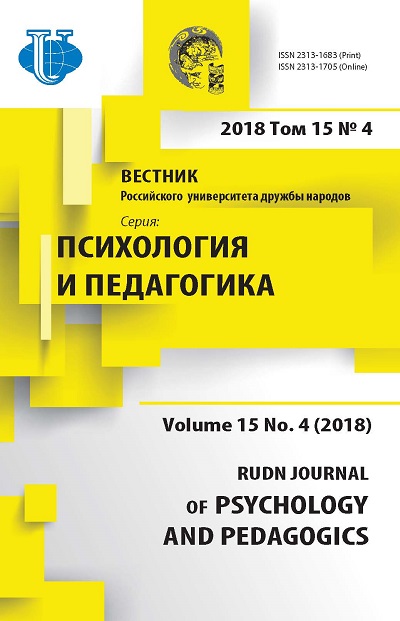Relationships of Victimization, Machiavellianism and Conflict Behavior
- Authors: Sheinov V.P1
-
Affiliations:
- National Institute for Higher Education (NIHE)
- Issue: Vol 15, No 4 (2018)
- Pages: 431-445
- Section: PERSONALITY AND SOCIAL PSYCHOLOGY
- URL: https://journals.rudn.ru/psychology-pedagogics/article/view/20372
- DOI: https://doi.org/10.22363/2313-1683-2018-15-4-431-445
Cite item
Full Text
Abstract
The article establishes the mutual links between the victimization, personal Machiavellianism and the conflict-handling modes. Many of these relationships depend on gender and age. A total of 732 subjects participated in the study: 285 women, 110 men, 180 girls and 157 boys. The victimization of subjects was evaluated using the author’s test of victimization for adults, Machiavellianism was evaluated with the help of the Mac-IV test, conflict-handling modes was evaluated with the TKI test. Victimization is associated with Machiavellianism, which correlates positively with general victimization, aggressive and uncritical behavior in men, women, boys and girls. In addition, the Machiavellianism in men, women and young men is positively associated with the addictive behavior and with realized victimization, the Machiavellianism of young men and women is associated with self-destructive and non-critical behavior, in young men it is associated with dependent behavior and with realized victimization. The nature of the relationship between victimization and conflict-handling modes is different for the components of victimization and modes. The Competing in men and women, boys and girls is positively associated with general victimization and aggressive behavior. The Accommodating in women and men is negatively correlated with general victimization and aggressive behavior, and in women it is associated with self-destructive and non-critical behavior. The Avoiding in women is negatively correlated with self-destructive and non-critical behavior and with realized victimization, in men it is positively associated with dependent behavior, and in young men it is associated with self-destructive behavior. Compromising in men, women, boys and girls is negatively correlated with general victimization and aggressive behavior. The Collaborating is negatively associated with general victimization and with aggressive behavior in young men and women, and in young men it is also associated with uncritical behavior. The Machiavellianism of men, women and young men is positively associated with Competing and it is negatively associated with Accommodating.
Keywords
About the authors
Viktor P Sheinov
National Institute for Higher Education (NIHE)
Author for correspondence.
Email: sheinov1@mail.ru
Doctor of Sociology, Professor, Professor of the Department of Psychology and Pedagogical Excellence, National Institute for Higher Education (Minsk, Belarus)
15 Moskovskaya St., Minsk, 220001, BelarusReferences
- Andronnikova, O.O. (2004). Test sklonnosti k viktimnomu povedeniyu. Razvitie gumanitarnogo obrazovaniya v Sibiri (iss. 9, pp. 11—25). Novosibirsk: NGPI Publ. (In Russ.)
- Balducci, C., Cecchin, M., Fraccaroli, F. (2012). The impact of role stressors on workplace bullying in both victims and perpetrators, controlling for personal vulnerability factors: A longitudinal analysis. An International Journal of Work, Health & Organisations, 26(3), 195—212.
- Bendas, T.V. (2005). Gender psychology. Saint Petersburg: Piter Publ. 431 p. (In Russ.)
- Greben, N.F. (2007). Psikholgicheskie testy dlya professionalov. Minsk: Sovremennaya shkola. 496 p. (In Russ.)
- Katunin, D.B. (2006). Polovozrastnye i gendernye osobennosti tendencii k manipulyativnomu povedeniyu. Ph.D. in Psychology Thesis Abstract. Saint Petersburg. 26 p. (In Russ.)
- Kodellas, S., Fisher, B. S., & Wilcox, P. (2015). Situational and dispositional determinants of workplace victimization. The effects of routine activities, negative affectivity, and low self-control. International Review of Victimology, 21(3), 321—342. doi: 10.1177/0269758015591930
- Lanctôt, N., & Guay, S. (2014). The aftermath of workplace violence among healthcare workers: A systematic literature review of the consequences. Aggression and Violent Behavior, 19(5), 492— 501. doi: 10.1016/j.avb.2014.07.010
- Loerbroks, A., Weigl, M., Li, J., Glaser, J., Degen C., & Angerer P. (2015). Workplace bullying and depressive symptoms: A prospective study among junior physicians in Germany. Journal of Psychosomatic Research, 78(2), 168—172. doi: 10.1016/j.jpsychores.2014.10.008
- McIlwain, D. (2003). Bypassing empathy: A Machiavellian theory of mind and sneaky power. In Repacholi, B. & Slaughter, V. (Eds.). Individual differences in theory of mind: Implications for typical and atypical development (pp. 39—66). New York, NY, US: Psychology Press.
- Menrath, I., Prüssmann, M., Müller-Godeffroy, E., Prüssmann, C., Ravens-Sieberer, U., OttovaJordan, V., & Thyen, U. (2015). Subjective Health, School Victimization, and Protective Factors in a High-Risk School Sample. Journal of Developmental & Behavioral Pediatrics, 36(5), 305—312. doi: 10.1097/DBP.00000000
- Ojha, H. (2007). Parent-Child Interaction and Machiavellian Orientation. Journal of the Indian Academy of Applied Psychology, 33(2), 285—289.
- Rumshina, L.I. (2003). Psikhologiya manipulirovaniya lyud’mi (tcennostno-smyslovoi aspekt. Rostovna-Donu. 141 p. (In Russ.)
- Schacter, H.L., & Juvonen, J. (2017). Depressive symptoms, friend distress, and self-blame: Risk factors for adolescent peer victimization. Journal of Applied Developmental Psychology, 51, 35—43. doi: 10.1016/j.appdev.2017.02.005
- Sheinov, V.P. (2012). Development of a questionnaire for assessing the degree of insecurity of an individual from manipulative influences. Voprosy psikhologii, (4), 147—154. (In Russ.)
- Sheinov, V.P. (2015). Assertiveness, internality, affiliation and insecurity of the individual from manipulation: connections and properties. Sistemnaya psikhologiya i sociologiya, (14), 107—113. (In Russ.)
- Sheinov, V.P. (2016). Personality qualities enhancing its security against manipulation. RUDN Journal of Psychology and Pedagogics, (3), 20—27. (In Russ.)
- Sheinov, V.P. (2017a). Vulnerability to manipulation and its relation to cognitive and personality features in adolescents. RUDN Journal of Psychology and Pedagogics, 14( 2), 167—177. doi: 10.22363/23131683-2017-14-2-167-177 (In Russ.)
- Sheinov, V.P. (2017б). Insecurity of students from manipulation and their psychological sex, locus of control and self-confidence. Sistemnaya psikhologija i sociologiya, 21(1), 35—46. (In Russ.)
- Thomas, K.W., Kilmann, R.H. (1974; 2007). Thomas — Kilmann Conflict Mode Instrument. Mountain View, CA: Xicom, a subsidiary of CPP, Inc.
- Turner, H.A., Shattuck, A., Finkelhor, D., & Hamby, S. (2016). Effects of Poly-Victimization on Adolescent Social Support, Self-Concept, and Psychological Distress. Journal of Interpersonal Violence, 32(5), 755—780. doi: 10.1177/0886260515586376
- Uludag, S., Colvin, M., Hussey, D., & Eng, A.L. (2009). Democracy, Inequality, Modernization, Routine Activities, and International Variations in Personal Crime Victimization. International Criminal Justice Review, 19(33), 265—286.
- Vishnevetsky, K.V. (2014). Victimization: factors, conditions, levels. Theory and practice of social development, 4, 226—227. (In Russ.)
- Znakov, V.V. (2000). Makiavelizm: psikhologicheskoe svoistvo lichnosti i metodika ego issledovaniya. Psikhologicheskii Zhurnal, 21(5), 16—22. (In Russ.)
















